CHAPTER 7
Shame and Regret
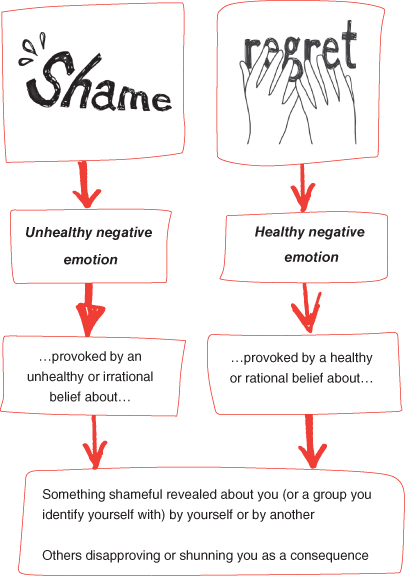
Shame and Embarrassment
Shame and embarrassment are feelings that are often experienced when there is either a real or a perceived public incident of some social gaffe. Both shame and embarrassment are provoked by unhealthy beliefs where you link your sense of worth to other people’s negative judgement.
You find yourself agreeing with the way you think other people will judge you for the social gaffe or faux pas. The unhealthy belief is often as follows:
‘Others must not disapprove of me for (whatever negative thing has been revealed about me), because if they do and then judge me as weak, inept, incompetent, a failure, worthless etc, they’d be right.’
We have worked with clients who also view the real or perceived social disapproval as the end of the world and as something intolerable. Almost all have had the self damning belief though.
Shame and embarrassment can trigger different physical symptoms and behaviours such as blushing, confusion, downward cast eyes, slack posture, lowered head, biting of lips or tongue, forced smile, fidgeting, being lost for words or having a blank mind.
Difference between Shame and Embarrassment
Shame and embarrassment are experienced about the same event, i.e. something negative has been revealed about me. The difference between them is that with shame, what’s been revealed is far more serious than with embarrassment as far as you’re concerned. It is subjective but we can all think of events that we would judge as embarrassing and events we would label as shameful. The roots of the word shame are thought to derive from an older word meaning ‘to cover’; as such, covering oneself, literally or figuratively. Embarrassment and shame can be experienced by a person even if it’s not specifically about that individual but about a group with which that individual identifies. For example, some cultures or some families within that culture perceive that they must rigidly adhere to certain behavioural rules and codes. Breaking such rules has resulted in aggressive, dangerous responses and sadly, in some cases, even murder. The person who has committed the shameful act is believed to be the ‘cause’ of the feeling of shame experienced by others as well as the ‘cause’ of the perceived shunning. As a consequence of this, anger and rage are provoked as a direct result of holding unhealthy beliefs about the person who has ‘caused’ the problem. It is not the person who has committed the ‘shameful’ act but the unhealthy beliefs others hold about it and about that individual that provoked feelings of shame and then anger.
Shame and Guilt
Shame and guilt are often misinterpreted or thought of as being the same. The focus of the shame provoking belief is other people’s disapproval, whereas the focus of the guilt provoking belief is one’s own disapproval of one’s self for having broken one’s own moral code.
Meta-Emotions of Shame and Embarrassment
A meta-emotion is an emotional problem about an emotional problem. For example, you can feel shame about feeling shame, depressed about feeling shame, angry about feeling shame and so on. You will know if you have a meta-emotion about your shame or embarrassment by asking yourself ‘how do I feel about my shame and embarrassment feelings?’
If you have a meta-emotion about your shame and embarrassment feelings then go to the relevant chapter for that particular emotion and work through it.
Common Shame and Embarrassment Triggers
The following are common themes of shame and embarrassment – the list is not exhaustive. Tick the boxes that you think apply to you.
| Tick the box to identify your shame and embarrassment triggers |
 Looking anxious Looking anxious |
 Showing any symptoms of anxiety Showing any symptoms of anxiety |
 Blushing Blushing |
 Sweating of head, face, armpits or hands Sweating of head, face, armpits or hands |
 Stuttering Stuttering |
 Forgetting Forgetting |
 Making mistakes Making mistakes |
 Not knowing something when asked Not knowing something when asked |
 Mind going blank Mind going blank |
 Soiling yourself in public Soiling yourself in public |
 Wetting yourself in public Wetting yourself in public |
 Having an anxiety attack or a panic attack Having an anxiety attack or a panic attack |
 Loss of control Loss of control |
 Being annoyed or angry Being annoyed or angry |
 Looking emotional Looking emotional |
 Acting emotionally Acting emotionally |
 Asking for more intimacy from partner Asking for more intimacy from partner |
 Approaching partner for intimacy Approaching partner for intimacy |
 Talking to partner about sex Talking to partner about sex |
 Talking about sex Talking about sex |
 Experiencing rejection Experiencing rejection |
 Being laughed at Being laughed at |
 Being the butt of someone’s joke Being the butt of someone’s joke |
 Being criticised Being criticised |
 Acting stupidly Acting stupidly |
 Being defeated Being defeated |
 Failing Failing |
 Being different Being different |
 Having a mental or emotional problem Having a mental or emotional problem |
 Having surgery Having surgery |
 Being ill/throwing up in public Being ill/throwing up in public |
 Losing some ability Losing some ability |
 Lacking some ability Lacking some ability |
 Physical appearance Physical appearance |
 Body shape and size Body shape and size |
 Specific body part Specific body part |
 Sexual performance Sexual performance |
 Sexual orientation Sexual orientation |
 Sexual desires Sexual desires |
 Sexual pleasure Sexual pleasure |
 Fainting in public Fainting in public |
 Other (write your own reason) Other (write your own reason) |
Am I Feeling Shame/Embarrassment or Regret?
At the heart of your shame/embarrassment feelings are unhealthy beliefs about being disapproved of by others for having committed some socially unacceptable behaviour, the consequences of which are negative judgement and rejection. Unhealthy beliefs that provoke shame/embarrassment impact on the way you think (cognitive consequences), act or tend to act (action tendencies).
When you feel shame/embarrassment, for example, your thoughts may be preoccupied with how others are judging you, thinking that you are incompetent and that they are right for thinking that way about you. You may avoid and remove yourself from that situation and that group of people. Assess if you are feeling shame/embarrassment or regret by checking your thoughts, actions and action tendencies.
Look through the illustrations for the cognitive consequences and actions/action tendencies and work out if you are feeling shame/embarrassment or regret. It is important to put yourself in the trigger situation when you felt uncomfortable. It is easy to think that you don’t have unhealthy thoughts when you are not triggered or when you are away from the trigger situation. Imagine yourself in the situation that triggered your feelings. Work out if the discomfort was shame/embarrassment or regret.
Cognitive Consequences
Shame/Embarrassment
You overestimate the shamefulness of the information revealed.
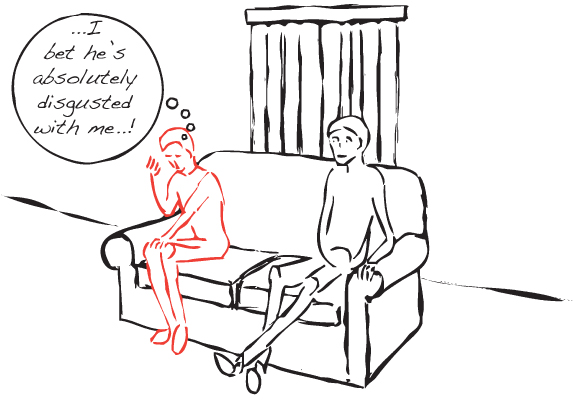
Cognitive Consequences
Regret
You see the information revealed in a compassionate, self accepting context.
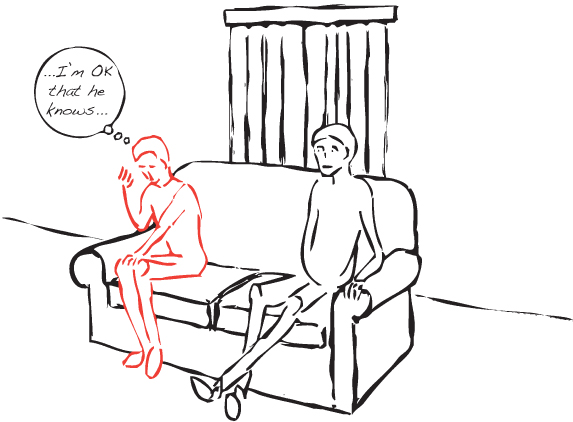
Cognitive Consequences
Shame/Embarrassment
You overestimate the likelihood that the judging group will notice or be interested in the information.

Cognitive Consequences
Regret
You are realistic about the likelihood that the judging group will notice or be interested in the information.
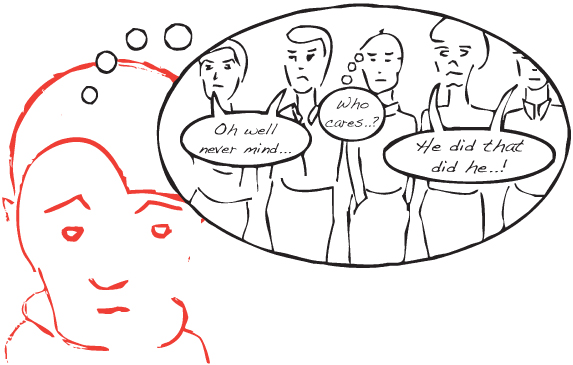
Cognitive Consequences
Shame/Embarrassment
You overestimate the degree of disapproval you will receive.
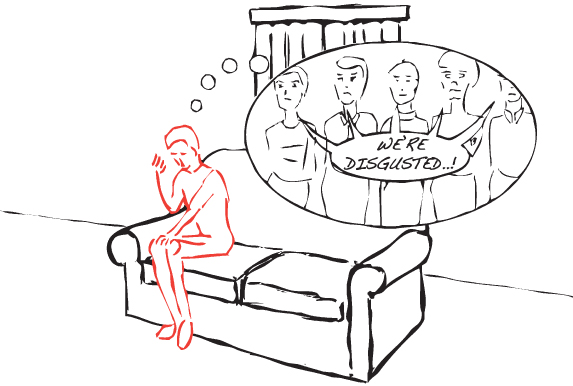
Cognitive Consequences
Regret
You are realistic about the degree of disapproval you will receive.
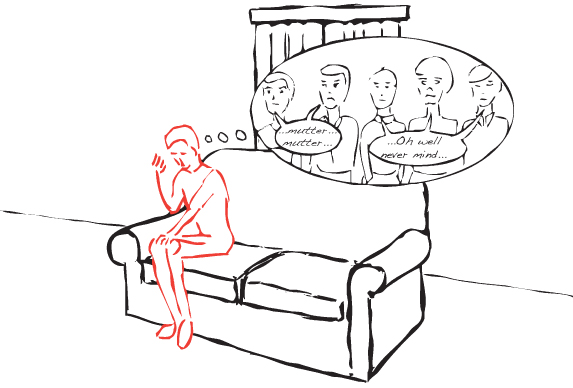
Cognitive Consequences
Shame/Embarrassment
You overestimate the length of time the disapproval will last for.

Cognitive Consequences
Regret
You are realistic about the length of time the disapproval will last for.

Action/Action Tendencies
Shame/Embarrassment
You remove yourself from the gaze of others.
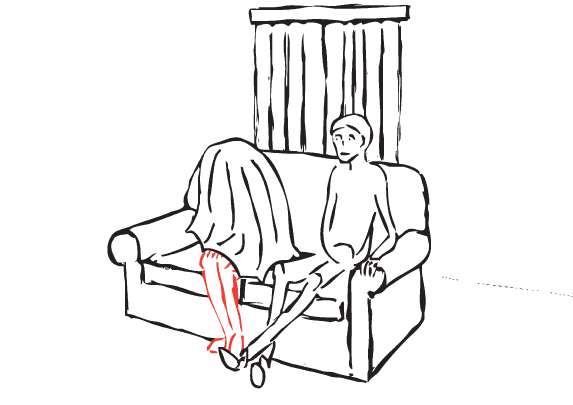
Action/Action Tendencies
Regret
You continue to participate actively in social interactions.
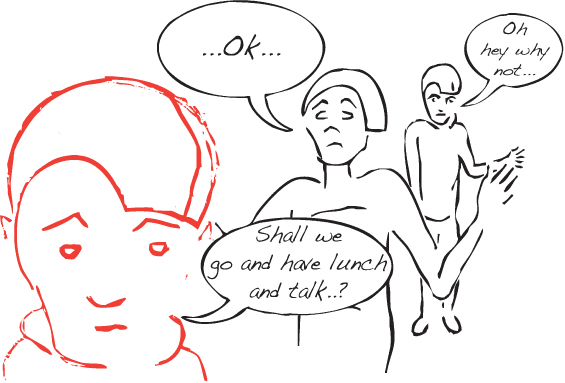
Action/Action Tendencies
Shame/Embarrassment
You isolate yourself from other people.
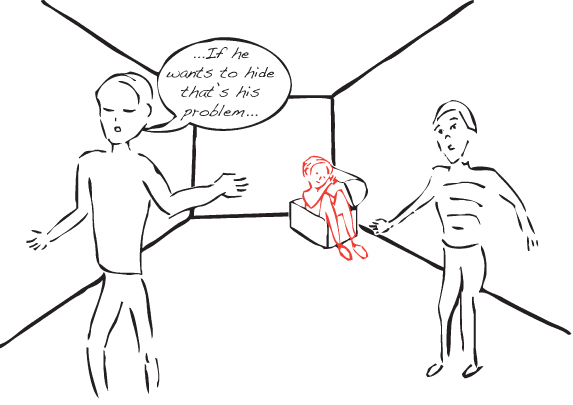
Action/Action Tendencies
Regret
You respond to attempts of others to restore the social equilibrium.
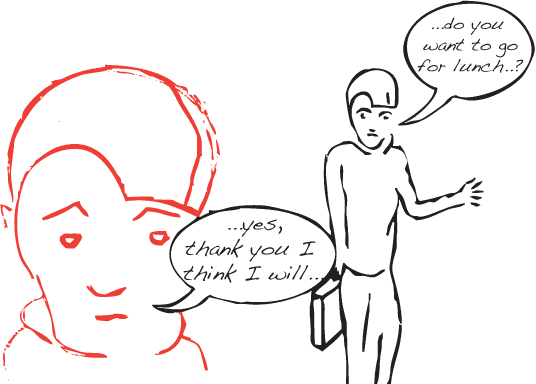
Action/Action Tendencies
Shame/Embarrassment
You save face by attacking others who have shamed you.
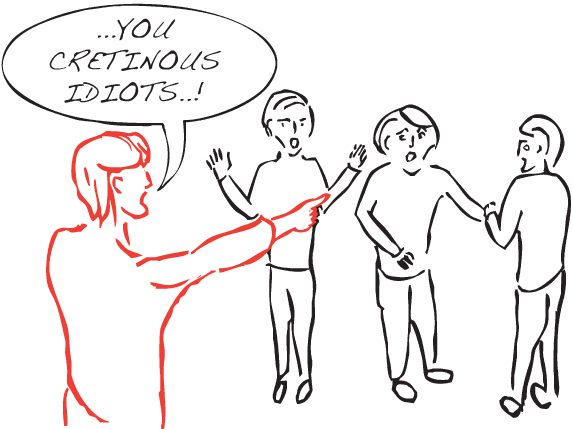
Action/Action Tendencies
Regret
You do not save face by attacking others.
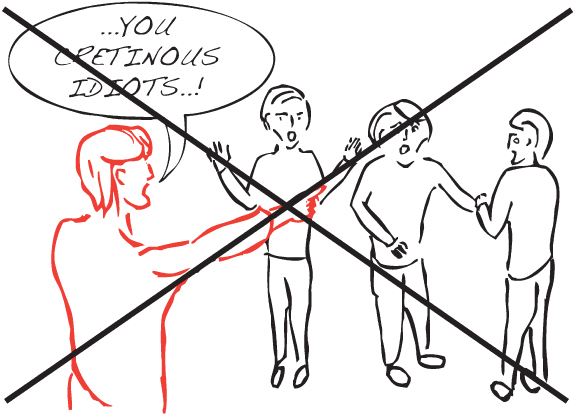
Action/Action Tendencies
Shame/Embarrassment
You defend your threatened self esteem in self defeating ways.

Action/Action Tendencies
Regret
You do not defend your self esteem as it is not threatened.
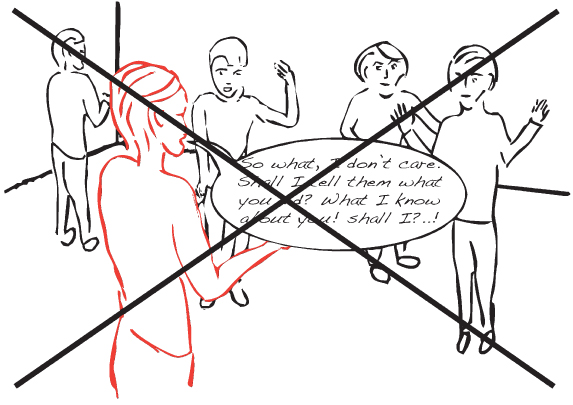
Action/Action Tendencies
Shame/Embarrassment
You ignore attempts by others to restore social equilibrium.
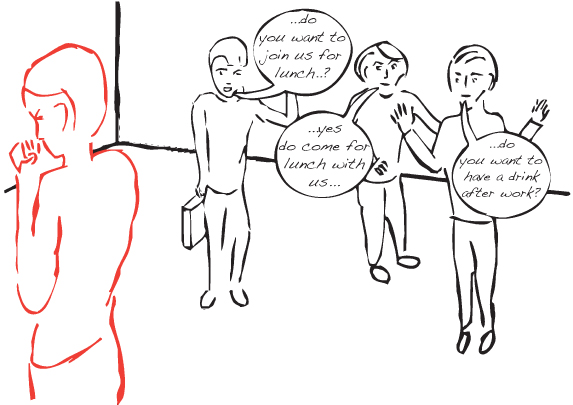
Action/Action Tendencies
Regret
You do not ignore attempts by others to restore social equilibrium.
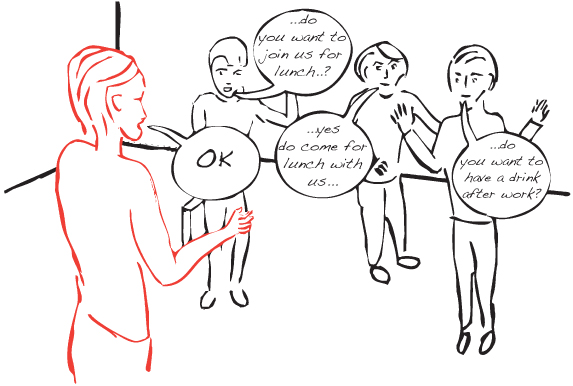
Now …
General Change or Philosophical Change for you?
General Change

Philosophical Change
Remember to take your time if you are choosing this route, as Philosophical Change is about changing your unhealthy beliefs over the long term.
Remember, shame/embarrassment is provoked by unhealthy beliefs about being disapproved of by others for having committed some socially unacceptable behaviour, the consequences of which are negative judgement and rejection. An unhealthy belief is made up of absolutist rigid beliefs – MUSTs, HAVE TOs, NEED TOs, GOT TOs, ABSOLUTELY SHOULDs, from which three further derivative beliefs come.
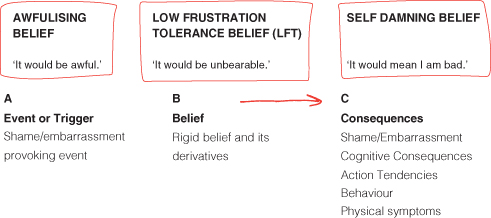
A rigid belief, at B, is a demand about the most shame/embarrassment provoking aspect of an event – it is a demand about how others must not disapprove of me for what has been revealed about me.
For example, if what you are most embarrassed about is your family finding out that you secretly binge, the rigid belief will be my family must not disapprove of me for secretly binging.
The fact that your rigid demand was not met triggers any or a combination of the three derivative beliefs.
For example:

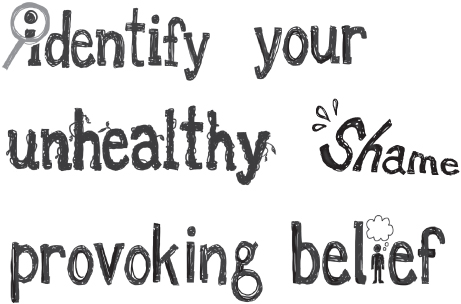
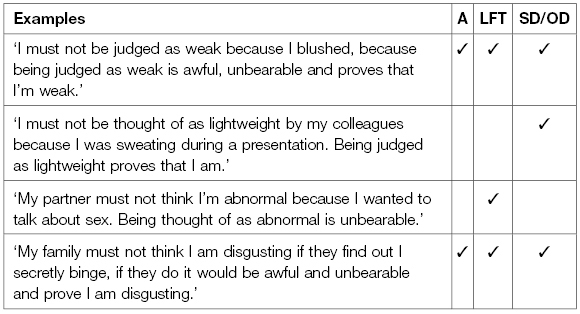
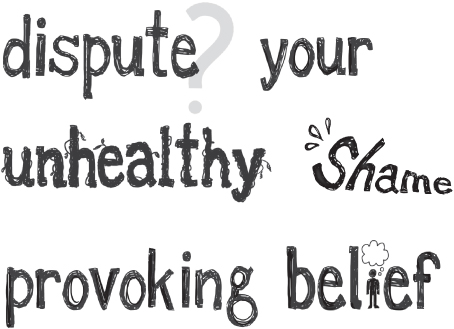
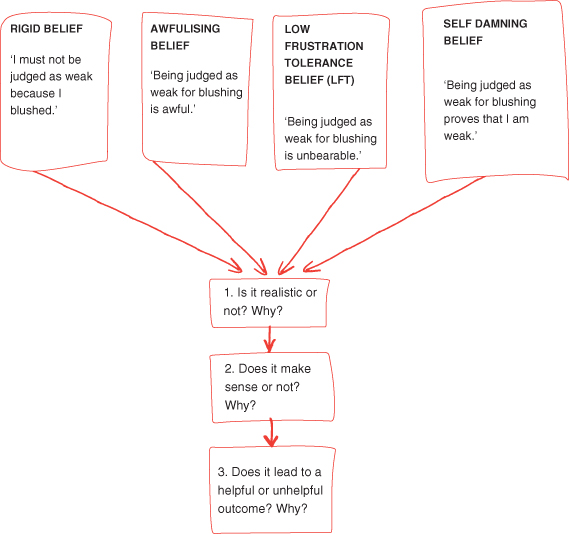
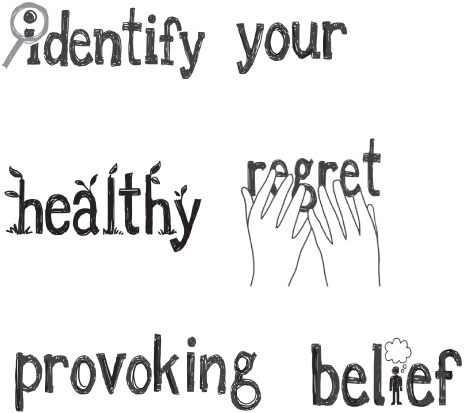
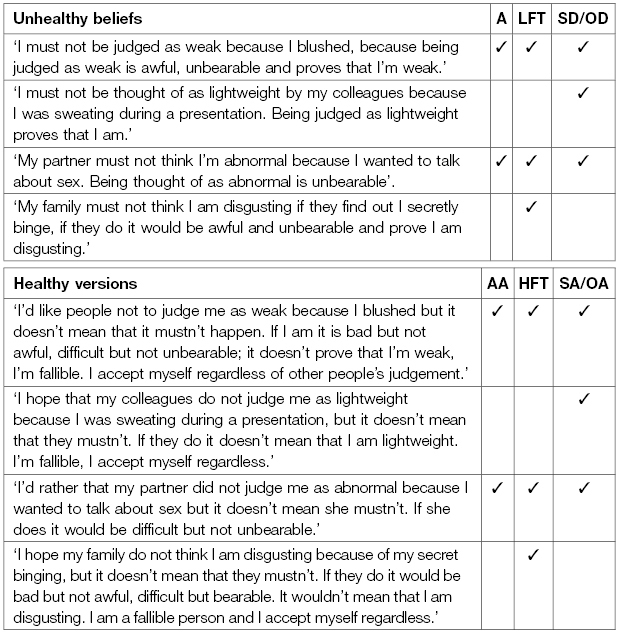
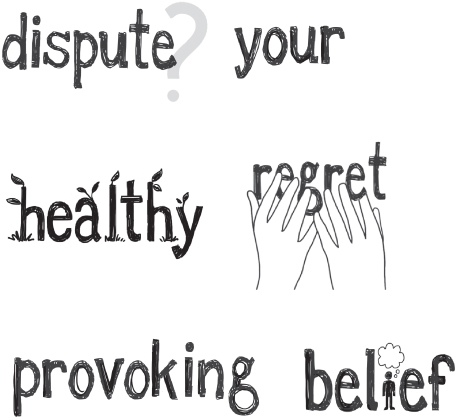
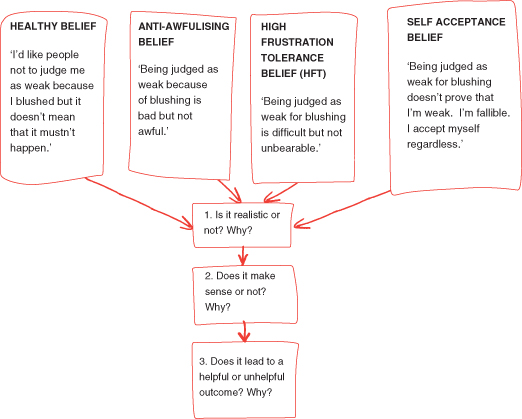
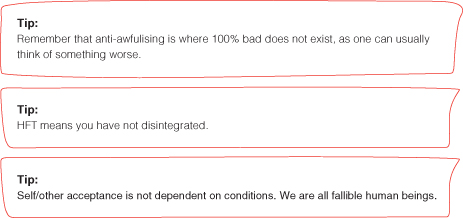
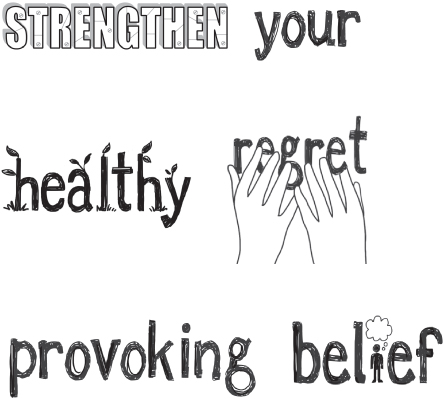

- Think and act in accordance with your healthy belief repeatedly and consistently in a forceful manner until eventually your emotional state changes from shame/embarrassment to a healthier one of regret.
- Remember your emotion of shame/embarrassment will change – the new way of thinking and the new actions you will implement will feel uncomfortable initially but this is completely natural. You are changing an old habit of unhealthy thinking and old habitual shame/embarrassment behaviours. It takes a few weeks of repetitions done consistently and forcefully.
- The behavioural goals you set for yourself need to be challenging but not overwhelming. If you overwhelm yourself then it defeats the object of the exercise.
- Start with imagining yourself thinking and acting in a healthy manner whilst being in the trigger situation until you think you are ready to challenge yourself in real life. For example, imagine yourself talking to your partner about sex whilst reciting your healthy belief in your head.
- Repeat your healthy belief in your head daily and particularly when you are imagining yourself in the trigger situation. This mental rehearsal will help you to remember it when you deliberately face the trigger situation in real life.
- Once you achieve your desired goal, whatever it is, then you need to maintain the helpful thinking and actions. For example, continue to challenge yourself by putting yourself in situations where it’s possible to experience negative judgement
- Review how you did, each time you challenge yourself, and then work out what you can do differently or better the next time. Then do it. Do not demand perfection from yourself. The process of moving from shame/embarrassment to regret is uncomfortable and uneven. Some days you will make bigger strides when you challenge yourself and other days you will make small strides or even take a step back. The important thing is to accept that this can happen and then bring your focus back to what you are doing and continue with it.
- Remember, you didn’t learn to drive a car, ride a bicycle or learn to read overnight, it takes repetition and focus and consistency.
Chapter 7 – Shame – Takeaway Tips
Shame Attacking Exercises
If you really want to free yourself from the grips of shame/embarrassment and learn to accept yourself unconditionally as a fallible human being regardless of other people’s disapproval then you can engage in shame attack.
Shame attacking exercises involve you doing something that you would find shameful or embarrassing and then thinking in accordance with your healthy belief.
The following are examples of clients who committed to and engaged in shame attacking:
Example 1
The client was most anxious about the thought of fainting in a busy train carriage because the idea of other people’s judgement as ‘this person is odd and abnormal’ felt embarrassing. The shame attacking exercise involved the client pretending to faint by dropping to the floor in the carriage of the busy train and lying there whilst reciting ‘I really hope people are not judging me as abnormal for fainting but it doesn’t mean they mustn’t. If they do, it wouldn’t mean that I’m abnormal, I accept myself regardless.’
This was carried out a few times and each time the client ended up with a seat and some warm attention from some but not from everyone. Eventually, the client accepted that some people may judge you, others may be indifferent and some show concern for your well-being.
Example 2
A client had anxiety about vomiting in public. The thought of others being repulsed by him triggered intense embarrassment. He agreed to pretend to throw up in a carrier bag whilst sitting on the bus. The client reported that some people moved away, some people were indifferent and a few came over and checked that he was OK. He was reciting his healthy belief before, during and after the exercise.